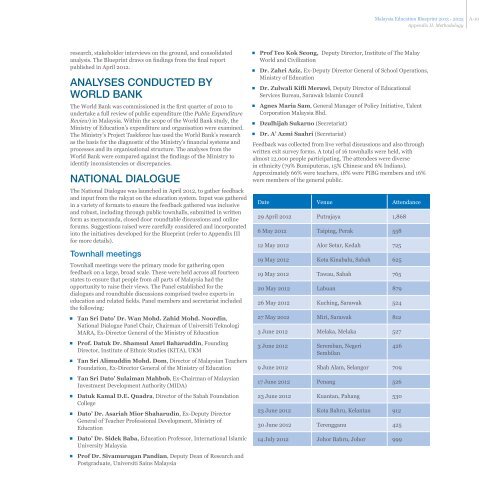Preliminary-Blueprint-Eng
Preliminary-Blueprint-Eng
Preliminary-Blueprint-Eng
Create successful ePaper yourself
Turn your PDF publications into a flip-book with our unique Google optimized e-Paper software.
esearch, stakeholder interviews on the ground, and consolidated<br />
analysis. The <strong>Blueprint</strong> draws on findings from the final report<br />
published in April 2012.<br />
analyses conducted By<br />
world BanK<br />
The World Bank was commissioned in the first quarter of 2010 to<br />
undertake a full review of public expenditure (the Public Expenditure<br />
Review) in Malaysia. Within the scope of the World Bank study, the<br />
Ministry of Education’s expenditure and organisation were examined.<br />
The Ministry’s Project Taskforce has used the World Bank’s research<br />
as the basis for the diagnostic of the Ministry’s financial systems and<br />
processes and its organisational structure. The analyses from the<br />
World Bank were compared against the findings of the Ministry to<br />
identify inconsistencies or discrepancies.<br />
natIonal dIalogue<br />
The National Dialogue was launched in April 2012, to gather feedback<br />
and input from the rakyat on the education system. Input was gathered<br />
in a variety of formats to ensure the feedback gathered was inclusive<br />
and robust, including through public townhalls, submitted in written<br />
form as memoranda, closed door roundtable discussions and online<br />
forums. Suggestions raised were carefully considered and incorporated<br />
into the initiatives developed for the <strong>Blueprint</strong> (refer to Appendix III<br />
for more details).<br />
townhall meetings<br />
Townhall meetings were the primary mode for gathering open<br />
feedback on a large, broad scale. These were held across all fourteen<br />
states to ensure that people from all parts of Malaysia had the<br />
opportunity to raise their views. The Panel established for the<br />
dialogues and roundtable discussions comprised twelve experts in<br />
education and related fields. Panel members and secretariat included<br />
the following:<br />
▪ Tan Sri Dato’ Dr. Wan Mohd. Zahid Mohd. Noordin,<br />
National Dialogue Panel Chair, Chairman of Universiti Teknologi<br />
MARA, Ex-Director General of the Ministry of Education<br />
▪ Prof. Datuk Dr. Shamsul Amri Baharuddin, Founding<br />
Director, Institute of Ethnic Studies (KITA), UKM<br />
▪ Tan Sri Alimuddin Mohd. Dom, Director of Malaysian Teachers<br />
Foundation, Ex-Director General of the Ministry of Education<br />
▪ Tan Sri Dato’ Sulaiman Mahbob, Ex-Chairman of Malaysian<br />
Investment Development Authority (MIDA)<br />
▪ Datuk Kamal D.E. Quadra, Director of the Sabah Foundation<br />
College<br />
▪ Dato’ Dr. Asariah Mior Shaharudin, Ex-Deputy Director<br />
General of Teacher Professional Development, Ministry of<br />
Education<br />
▪ Dato’ Dr. Sidek Baba, Education Professor, International Islamic<br />
University Malaysia<br />
▪ Prof Dr. Sivamurugan Pandian, Deputy Dean of Research and<br />
Postgraduate, Universiti Sains Malaysia<br />
Malaysia Education <strong>Blueprint</strong> 2013 - 2025<br />
Appendix II. Methodology<br />
▪ Prof Teo Kok Seong, Deputy Director, Institute of The Malay<br />
World and Civilization<br />
▪ Dr. Zahri Aziz, Ex-Deputy Director General of School Operations,<br />
Ministry of Education<br />
▪ Dr. Zulwali Kifli Merawi, Deputy Director of Educational<br />
Services Bureau, Sarawak Islamic Council<br />
▪ Agnes Maria Sam, General Manager of Policy Initiative, Talent<br />
Corporation Malaysia Bhd.<br />
▪ Dzulhijah Sukarno (Secretariat)<br />
▪ Dr. A’ Azmi Saahri (Secretariat)<br />
Feedback was collected from live verbal discussions and also through<br />
written exit survey forms. A total of 16 townhalls were held, with<br />
almost 12,000 people participating. The attendees were diverse<br />
in ethnicity (79% Bumiputeras, 15% Chinese and 6% Indians).<br />
Approximately 66% were teachers, 18% were PIBG members and 16%<br />
were members of the general public.<br />
Date Venue Attendance<br />
29 April 2012 Putrajaya 1,868<br />
6 May 2012 Taiping, Perak 558<br />
12 May 2012 Alor Setar, Kedah 725<br />
19 May 2012 Kota Kinabalu, Sabah 625<br />
19 May 2012 Tawau, Sabah 765<br />
20 May 2012 Labuan 879<br />
26 May 2012 Kuching, Sarawak 524<br />
27 May 2012 Miri, Sarawak 812<br />
3 June 2012 Melaka, Melaka 527<br />
3 June 2012 Seremban, Negeri<br />
Sembilan<br />
426<br />
9 June 2012 Shah Alam, Selangor 709<br />
17 June 2012 Penang 526<br />
23 June 2012 Kuantan, Pahang 530<br />
23 June 2012 Kota Bahru, Kelantan 912<br />
30 June 2012 Terengganu 425<br />
14 July 2012 Johor Bahru, Johor 999<br />
A-10


